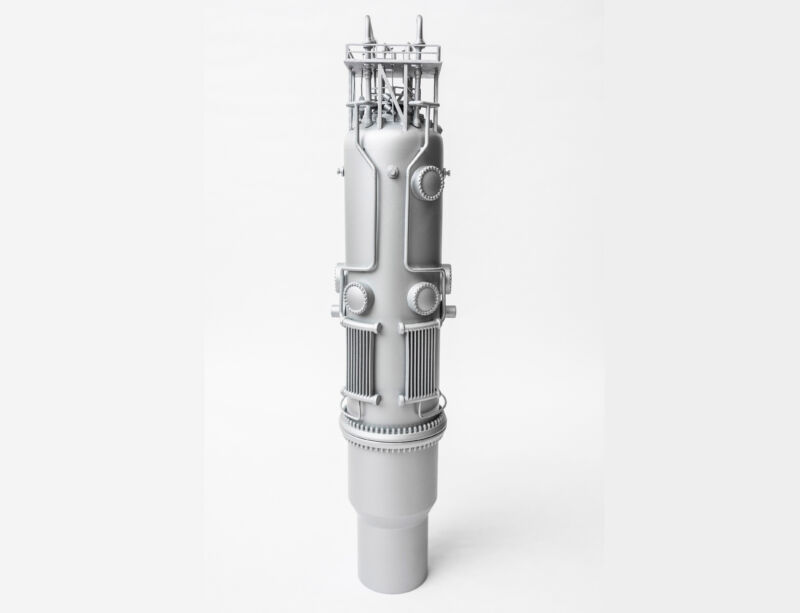
In the summer we wrote that the American company NuScale Power has received approval from the US Nuclear Regulatory Commission for the design of a small modular reactor. The model, developed by the company, is designed for 50 megawatts. In a couple of years, an application for a more powerful 60 megawatt reactor will be considered.
A couple of weeks ago, the company received a state contract from the Department of Energy for an impressive $ 1.35 billion . True, there are also problems, where without them.
First, about the good. The funds allocated by the state will go towards the construction of the first modular nuclear power plant with several small nuclear reactors. Construction is slated to begin in 2025, with a test launch in 2029.
The funds have already been allocated, and a number of US cities have signed an agreement to participate in the project. But in order for the project to be implemented, a number of problems must be overcome
Modular NPP project problems
Firstly, 36 cities signed the agreement, but later 8 of them withdrew from the agreement . Local authorities were frightened by the possibility of a rise in the price of the project. About $ 3 billion was initially requested for its implementation, but then the cost increased to $ 6.1. It may well be that it will continue to rise in price. The cities that signed the contract pledged to allocate part of the funds for the project in exchange for energy.
Secondly, the term for the creation of a modular nuclear power plant is constantly postponed either by several months or by a couple of years. There is information that the start of work may be postponed to 2027 (instead of 2025). Accordingly, the launch of the nuclear power plant will take place after 2030. It is not yet certain, but all the prerequisites for delaying the deadline are there.
Third, it is believed that a modular nuclear power plant is much more profitable than a conventional one. It also plays a role in the fact that the construction of a modular facility requires much less time than in the case of a traditional nuclear power plant, and the fact that individual reactors-modules can be shut down if the demand for energy falls. Everything would be good, but if the station does not work at full capacity, then its profitability decreases . Experts have calculated that, under certain conditions, the use of "green" energy together with batteries of the type that Musk makes is more profitable than a modular nuclear power plant.
So far so good
However, everything mentioned above is still only a potential threat. Yes, the project is difficult to implement, but the necessary work is in progress. In addition, the allocation of funds by the state means the trust of officials in the project.
The design capacity of the NPP is 720 megawatts, if 12 60-MW modules are installed. Moreover, an area of 13 hectares has already been allocated for the NPP.

According to the developers, small reactors are much safer than conventional ones. In addition, they can be used in small towns, industrial facilities and submarines.
An additional advantage is the small number of employees of the modular NPP. The total number of personnel of a traditional NPP reaches 1000 people. If on the territory of the station there is also a complex for the processing of radioactive waste, a storage facility for spent fuel, etc., then the staff may be larger. In the case of a modular NPP, we are talking about several dozen employees, in rare cases - a couple of hundred.
Another plus is that individual modules can be replaced, removed, upgraded. This cannot be done with a conventional nuclear power plant: if the reactors are built, then it will not be possible to radically change their design.
What is NuScale Power?
A separate module is a steel cylinder 23 meters high and 5 meters wide. Inside are uranium fuel rods that heat the water in the internal circuit. Through a heat exchanger, hot water transfers heat energy to an external steam circuit, where a turbine is driven, which generates electricity. During operation, the steam is cooled and the water droplets return to the internal circuit.
If something happens, the reactor is able to automatically silence the reaction using the control rods. They stop the exchange of neutrons, after which the chain reaction stops.
The project already has one customer, Utah Associated Municipal Power System, the organization that will build a modular nuclear power plant at Idaho National Laboratory. If all goes well, then by 2030 the world will have a nuclear power plant of an original design with a number of opportunities that all other nuclear power plants did not have and do not have.
